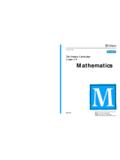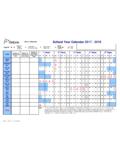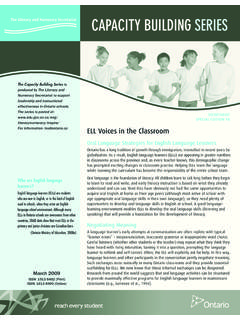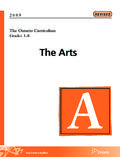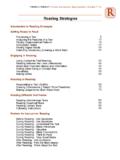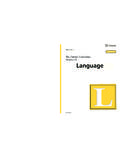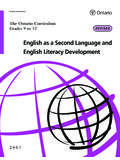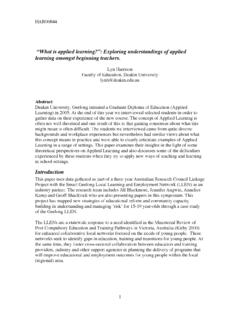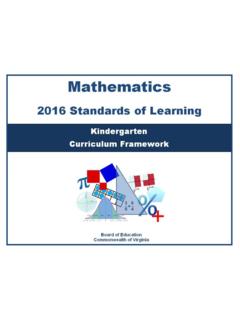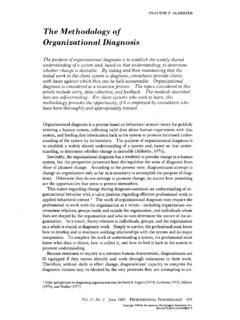Transcription of Capacity Building Series - Ontario
1 Capacity Building Series SECRETARIAT. SPECIAL EDITION #16. collaborative teacher inquiry New Directions in Professional Practice Models of teacher -driven inquiry have existed for many years ( , Little, 1982). However, with increased support and attention to teacher collaborative processes, Why engage in teacher inquiry ? both within schools and across them in hubs and networks, the role of teacher inquiry is emerging as a critical part of the daily work of teachers. In effect, collaborative We don't inquire to eliminate alternatives teacher inquiry is rapidly becoming a commonly held stance within professional but to find more functional understandings practice in Ontario as we transform our conceptions of professional learning (Hannay, to create diversity, broaden our thinking Wideman, & Seller, 2010). and ask more complex questions. On the basis of research literature, as well as on the current work of Ontario teachers, (Burke & Short, 1991) principals and board leaders, this monograph identifies seven characteristics of collaborative teacher inquiry .
2 Several teacher collaboratives supported by the Ontario Ministry of Education, the Kindergarten/Grade One collaborative inquiry , the collaborative inquiry for learning : Mathematics (CIL-M) and the Student Work Study, are the source for the teacher voices in the pages that follow. Engaging Teachers as Learners Through collaborative inquiry , teachers integrate new knowledge and understanding of student learning and classroom instruction into their existing knowledge of professional practice. For those engaged in inquiry , the process can serve to expand and refine their personal knowledge base about what it means to be a teacher (Earl, in press). inquiry constructs understanding of the classroom encounter . where instruction, curriculum and student actions intersect (Moore, 2004). The Capacity Building Series is produced by The Literacy and September 2010 The Literacy and Numeracy Secretariat Numeracy Secretariat to support leadership and instructional effectiveness in Ontario schools.
3 The Series is posted at: ISSN: 1913 8482 (Print) ISSN: 1913 8490 (Online) For information: In practice, inquiry engages teachers as learners in critical and creative thinking. It honours openness and flexibility. Through collaborative dialogue, teachers seek emergent possibilities new questions and solutions to student learning and achieve- ment. This stance is iterative, repeating progressively as teachers reflect and build on each successive inquiry . Teachers say .. inquiry positions the teacher as an informed practitioner refining planning, instruction We can bounce ideas off each other. If one of and assessment approaches in the continual pursuit of greater precision, personaliza- us is having a hard time prompting a student tion and innovation. A focus on student learning drives inquiry . Data generated in a certain way, the other one just naturally from student actions and work compel teachers to investigate new, engaging and falls into place.
4 So just having that new relevant questions about how and what their students learn. These questions lead learning process with [co-teaching in our to informed actions within the classroom, which in turn serve to refine or initiate collaborative inquiry and] having another new investigations. person there has been great.. Seven Characteristics of teacher inquiry The climate had to be established that it was okay to take a risk; we needed to have a Currently in Ontario , collaborative teacher inquiry is used in professional learning communities, school networks, action research partnerships and a range of other venue to have courageous conversations . inquiry -based projects. Within the collaborative inquiry approach, the following The climate is so important because we characteristics play a critical role in generating opportunities for new understandings were able to talk about our struggles.. and actions.
5 1. RELEVANT. STUDENT learning GUIDES inquiry . The primary purpose of all inquiry within the context of instructional practice is to meet the needs of students by engaging them in rich, personally relevant learning . With the learning process positioned at the heart of inquiry , accurately describing student learning becomes an anchor for the process. Consequently, assessment for learning is integral to engaging in professional inquiry . The learning process of students (What is the student saying about his/her thinking during a task? ) as well as the products of their learning form the essential material of the inquiry . The ability to analyze the evidence ( , transcriptions, anecdotal notes, photographs, videos, podcasts, oral recordings) with colleagues is key to the effectiveness of the process. Professional dialogue that focuses on authentic student-centred issues leads to further predictions and/or questions regarding how students might best learn within a specific context.
6 Here, classroom-based description and analysis help generate new knowledge and insights that may have both immediate and longer-term consequences for teaching and learning . 2. How Student learning Guides inquiry Starting with what students are learning Starting with beliefs about teaching and learning 1. Describe what the students are doing and learning . 1. From the focus of inquiry , construct an If then statement. This state- ment identifies the specific relationship between teaching and learning under exploration. For example, If I ask students to articulate their understanding orally 2. How do we know what we know? Consider the quality of evidence that we while they are working, then their work improves. are using to answer the question: Does the evidence compare the relation between teaching and learning ? 2. List evidence that would and would not support this statement. Does the evidence draw on personal experience?
7 Evidence that would support this Evidence that would not support statement this statement Does the evidence draw on external sources? Does the evidence go beyond the statement? 3. What are the possible reasons that the students responded in the way that they did? 3. Consider the quality of evidence in each column. Does the evidence compare the relation between teaching and learning ? Does the evidence draw on personal experience? 4. What do students need to do next and what do teachers need to do to get Does the evidence draw on external sources? them there? Does the evidence go beyond the statement? 4. Make an instructional plan to collect the evidence that will test the statement. After new actions are taken . 5. What did we learn about our students? What can we adapt, revise and refine in our understanding of student learning ? For additional information about assessment for student learning , see Ontario Ministry of Education (2010) and Literacy and Numeracy Secretariat (2010).
8 2. collaborative . teacher inquiry IS A SHARED PROCESS. Although the mandate to reach every student seems simple, achieving this goal is complex. When educators work together to inquire about their students' learning and engagement, they embrace this complexity as an opportunity for further under- standing rather than something to simplify. New Webcasts from LNS. The vast majority of teaching time is spent alone with students in the classroom. Word Study in Action However, the collaborative nature of inquiry is what enables the learning to go deeper. Developing Inquiring Minds Collaboration provides perspective, diversity and space for teachers to consider questions about student learning that can provide new insight unavailable in inquiry Precision Teaching in the Primary processes that are done individually. Finding common ground for all teachers to engage Classroom authentically together requires negotiation.
9 Tools such as discourse analysis may help to build a unified focus of study. Tips for Practice Discourse Analysis In the Analytic Discourse Process (adapted from Sagor, 1992), each participant has an opportunity to be interviewed about aspects of teaching and learning they are interested in exploring as a part of the inquiry . Participants take on one of four roles: interviewee, interviewer, reality checker and recorder. Additional participants can serve as additional reality checkers. Once the first participant has been interviewed, the roles rotate until each participant has had an opportunity to be the interviewee. 3. Finally the conversation opens up to discuss the common and divergent interests and how they can be explored under a common inquiry focus. The following chart offers guidelines for participants as they take on each role. Roles Guidelines Teachers say .. Interviewee Detail the issues you are most interested in exploring as a part The data or the student work' is actually of your classroom practice.
10 More than just the finished product, [it's] the Interviewer Only ask questions, offer no solutions, give no critical comments. process, the behaviours, the conversations and Reality Checker Listen and identify issues that emerge from the conversation the non-verbal and verbal communication. that are feasible as an inquiry focus. We have learned that perhaps the highest Recorder Record the conversation. impact we can have on our students is taking the time to talk with them and connect with them. 3. REFLECTIVE. My experience in the CIL-M project ACTIONS ARE INFORMED BY REFLECTION. demonstrated that the process of co-teaching Reflection is a critical part of analysis in applied research. Actions taken as a result of can provide remarkable benefits for ongoing inquiry inform understanding of the kinds of conditions that support further educators and students. Co-teaching not student learning . only greatly enhanced my understanding of When teachers make pedagogical decisions, they reflect on students' engagement mathematics and how to teach the subject, and learning resulting from their past decisions (Schon, 1983).
